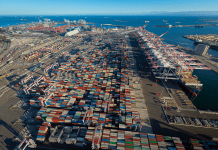
In the dynamic world of global shipping, understanding the capacity and fleet size of major container line operators is crucial.
The latest orderbook rankings, sourced from Alphaliner and presented by Container News, offer a clear snapshot of where the industry giants stand in terms of TEU and the number of ships on order.

At the forefront of this ranking, we find MSC leading with an impressive orderbook of 2,065,069 TEUs across 136 ships. This significant investment in new capacity underscores MSC’s ambition to maintain or expand its market dominance in the container shipping sector. Close behind is CMA CGM, with 1,148,949 TEUs spread over 75 ships, showcasing a robust plan for fleet renewal and growth.
COSCO holds the third position with 883,862 TEUs and 53 ships on order, signaling a strategic push to strengthen its position in international trade routes. Maersk follows with 774,572 TEUs and 54 ships.
Ocean Network Express (ONE) ranks fifth with an orderbook of 616,572 TEUs distributed among 48 ships, indicating a focused approach towards enhancing its fleet capabilities. Evergreen is not far behind with 572,795 TEUs and 49 ships, reflecting its ongoing commitment to expanding its global reach.
Hapag-Lloyd has 468,322 TEUs on order with 37 ships, aiming to keep pace with the industry’s growth. Wan Hai with 308,339 TEUs and 30 ships, continues to play a significant role in regional global trade.
Pacific International Lines (PIL) shows a more modest expansion with 230,984 TEUs across 23 ships, while X-Press Feeders, focusing on feeder services, rounds up the list with 98,256 TEUs and 15 ships.
This ranking highlights the scale of investments by the major ocean carriers, reflecting the competitive landscape where fleet modernization and capacity expansion are key points.
In conclusion, the container shipping industry is witnessing substantial investments in fleet expansion, as operators work to increase their capacity and strengthen their positions in global trade. The large orderbooks across the sector reflect a clear strategy of growth, modernization, and technological advancement.
This shift indicates a competitive landscape, with companies focusing on meeting evolving market demands while enhancing operational efficiency. As the industry continues to adapt to changing economic conditions and environmental considerations, these investments will likely shape the future of global shipping, ensuring continued progress in service delivery and fleet innovation.





